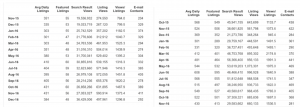 Zillow Group, which includes the websites of Zillow and Trulia have landed on a broker strategy for marketing that works. Zillow Group, which includes the websites of Zillow and Trulia have landed on a broker strategy for marketing that works. Featured listings are dead, and have been replaced with a product to advertise in ways that drive the largest margin opportunity for a brokerage firm – leads to eTeams and Relocation. I call this “shared display,” where the brokerage and agent are clearly displayed and may be contacted – easily understood as “your listing, same leads.” This functionality works equally well for any brokerage or large team.
Zillow Group, which includes the websites of Zillow and Trulia have landed on a broker strategy for marketing that works. Zillow Group, which includes the websites of Zillow and Trulia have landed on a broker strategy for marketing that works. Featured listings are dead, and have been replaced with a product to advertise in ways that drive the largest margin opportunity for a brokerage firm – leads to eTeams and Relocation. I call this “shared display,” where the brokerage and agent are clearly displayed and may be contacted – easily understood as “your listing, same leads.” This functionality works equally well for any brokerage or large team.
Display rules Primer.
There are three general types of display rules, Fair Display, Shared Display, and IDX Display.
- Fair Display is pretty simple to understand, if it’s your listing, then only your identity is displayed on the listing. Many people like this display because it’s “your listing, your lead.” It works like the new car dealer. You call BMW to buy BMW.
- The second type of display is a shared display. This shared display is where Zillow has innovated. Under the ad portal strategy, the listing agent and broker are always displayed on their listing and can receive leads. But the display is a shared display; so three other advertisers may be displayed on the listing if they pay. Lets understand that this is “your listing, same leads.” Our research shows that brokers get the same volume of leads on their listings with shared display as they did with fair display (read on).
- The third display is IDX display. In this display that is popularized on broker and agent websites, the site owner gets all the leads and the listing broker and agent have a bi-line. This is understood as “your listing, no leads.” This model is akin to a used car dealership where the company will sell all brands of cars.
Shared Display outperforms Fair Display
WAV Group performed A-B testing on Zillow that pitted two brokers who had the same number of listings on the site (one had 430 listings and the other had 431). The broker who paid for fair display, exclusively featuring the brokerage and agent branding, received 281 email contacts with 660,133 listing views. The broker with the free, shared display of 430 listings featuring competing agents, received 411 email contacts, 590,914 listing views. The free, shared display outperformed paid fair display by 130 consumer inquiries, or about 150% better.
To be provided with the shared display treatment that places the listing agent at the top of the buyers’ agent list, you just need to provide Zillow with a broker data feed. They do not charge for the shared display treatment. You will also provide Zillow with your unclickable logo, which will appear prominently on the page above the fold at the top of the screen, sandwiched between the property photos and the buyers’ agent list.
Another feature of Zillow Pro for Brokers is a video intro. You may be familiar with Channel Trailers on YouTube that welcomes unsubscribed visitors to your YouTube Channel. On the bottom of every Zillow Pro for Brokers is space that allows brokers to introduce their brokerage though a 60 second video.
Reallocation of Broker Advertising
Understanding that fair display is not as effective at driving leads, brokers may want to consider how to reallocate those dollars. The fair display advertising treatment was largely unleveraged in a brokerage. Predominantly, brokers direct leads on listings to the listing agent. This does not allow the broker to margin the leads beyond the commission agreement with the listing agent. Using different advertising vehicles with those dollars to drive relocation and referral business improves broker return on advertising dollars.
Where the broker can remargin the leads is by processing them through eTeams or relocation teams for incubation and outbound referrals. Brokers will typically margin the referral at a 50% commission. Real estate agents and teams have been doing this for years by leveraging advertising programs at Zillow Group, Realtor.com, and Homes.com. Return on investment typically runs between 5x and 10x for the leads derived from online advertising.
Problem Solved For Zillow
One of the big challenges that Zillow faced in 2015 was that major brands like NRT, Realogy Franchise Group, Keller Williams, RE/MAX, Howard Hanna, Long and Foster, Pacific Union, Weichert, Berkshire Hathaway, and many others were hiding advertising inventory with Fair Display deals. It blocked the buyers’ agent list on a significant quotient of available advertising inventory. By sun-setting the fair display ad product, brands are getting the shared display that they need without the investment tied to fair display. Zillow gets more advertising inventory in return. And oddly enough, shared display is driving more leads to everyone.
Some Other Intakes for Broker Online Ad Strategy
Response rates on internet generated leads is still in the toilet unless you apply a call center or eLead team to handle them. Howard Hanna acquired One Cavo to take care of this and selective friends of the Hanna’s may ask about using One Cavo to handle the lead center in their brokerage. Taking a page out of the One Cavo success plan, Zillow Group has launched a concierge service. They engage in the consumer inquiries and hand them off in a jump ball format to teams within a brokerage. It’s a hot hand off while the customer is still on the phone. This process delivers outstanding service to the consumer and drains the swamp of consumers who are unqualified leads. Lets face it, when you pour over 100 million consumers over a website each month, you get a lot of inquiries that have absolutely nothing to do with buying or selling property. If you brokerage does not have a hot system for managing consumer inquiries immediately, it is best that you step out of the lead generation game entirely. Electronic lead routing where you throw consumer inquiries over the fence and forget about them is a horrid business process that does more damage to your company than good. Its akin to not answering the phone at your brokerage, or not greeting consumers who walk into your office. Stop it!






Leave A Comment